2004 CHEVROLET KODIAK suspension
[x] Cancel search: suspensionPage 7 of 366
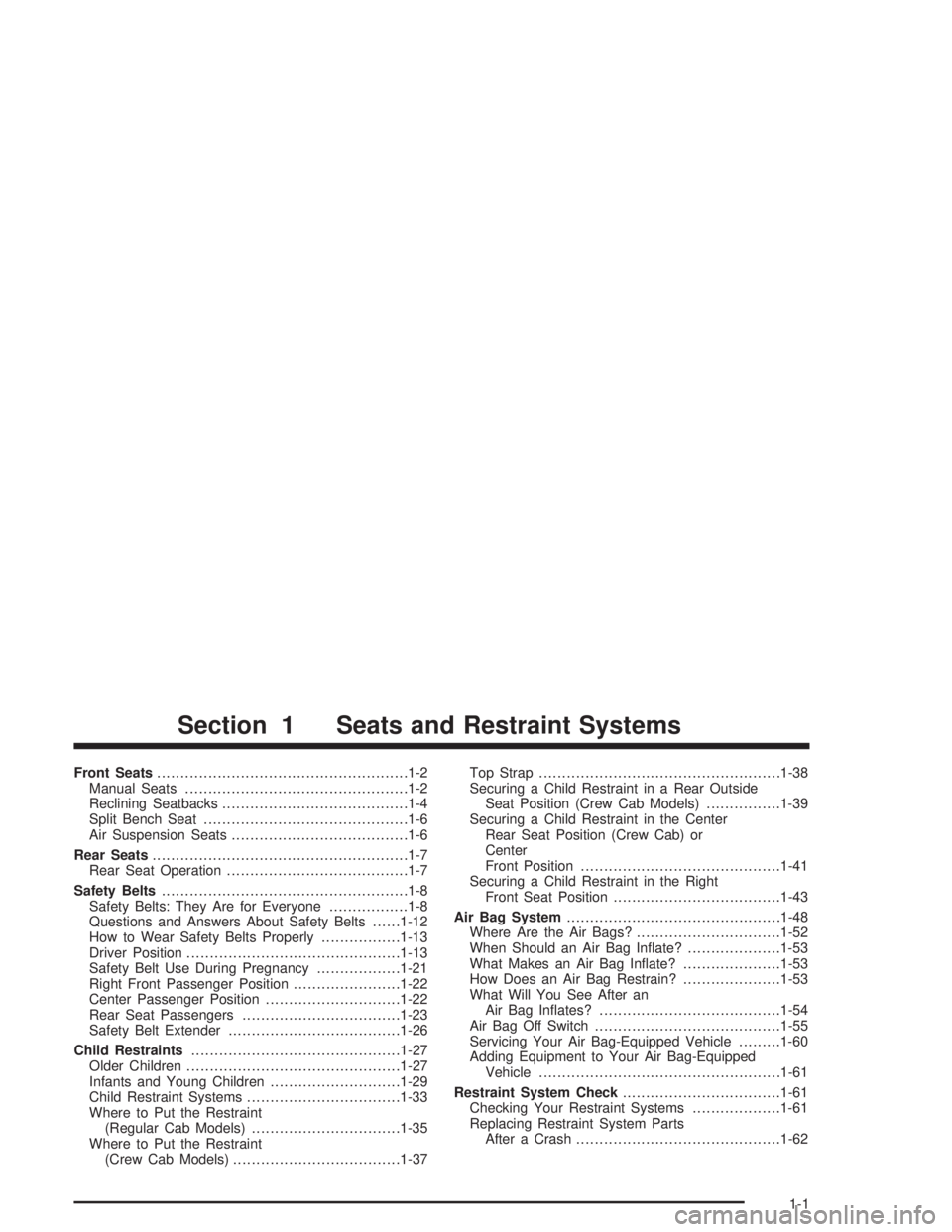
Front Seats......................................................1-2
Manual Seats................................................1-2
Reclining Seatbacks........................................1-4
Split Bench Seat............................................1-6
Air Suspension Seats......................................1-6
Rear Seats.......................................................1-7
Rear Seat Operation.......................................1-7
Safety Belts.....................................................1-8
Safety Belts: They Are for Everyone.................1-8
Questions and Answers About Safety Belts......1-12
How to Wear Safety Belts Properly.................1-13
Driver Position..............................................1-13
Safety Belt Use During Pregnancy..................1-21
Right Front Passenger Position.......................1-22
Center Passenger Position.............................1-22
Rear Seat Passengers..................................1-23
Safety Belt Extender.....................................1-26
Child Restraints.............................................1-27
Older Children..............................................1-27
Infants and Young Children............................1-29
Child Restraint Systems.................................1-33
Where to Put the Restraint
(Regular Cab Models)................................1-35
Where to Put the Restraint
(Crew Cab Models)....................................1-37Top Strap....................................................1-38
Securing a Child Restraint in a Rear Outside
Seat Position (Crew Cab Models)................1-39
Securing a Child Restraint in the Center
Rear Seat Position (Crew Cab) or
Center
Front Position...........................................1-41
Securing a Child Restraint in the Right
Front Seat Position....................................1-43
Air Bag System..............................................1-48
Where Are the Air Bags?...............................1-52
When Should an Air Bag Inflate?....................1-53
What Makes an Air Bag Inflate?.....................1-53
How Does an Air Bag Restrain?.....................1-53
What Will You See After an
Air Bag Inflates?.......................................1-54
Air Bag Off Switch........................................1-55
Servicing Your Air Bag-Equipped Vehicle.........1-60
Adding Equipment to Your Air Bag-Equipped
Vehicle....................................................1-61
Restraint System Check..................................1-61
Checking Your Restraint Systems...................1-61
Replacing Restraint System Parts
After a Crash............................................1-62
Section 1 Seats and Restraint Systems
1-1
Page 10 of 366

Fore-and-Aft Adjustment
The fore-and-aft
adjustment lever is located
underneath the seat, in
the front.
To slide the seat forward or rearward, move the lever
toward the driver’s door. The seat will lock in at 1/2 inch
(1.5 cm) increments.
{CAUTION:
If the seatback isn’t locked, it could move
forward in a sudden stop or crash. That could
cause injury to the person sitting there. Always
press rearward on the seatback to be sure it is
locked.
Reclining Seatbacks
If your vehicle has standard, non-suspension bucket
seats, you can recline the seatbacks. The lever is
located on the outboard side of the seat cushion.
To recline the seatback, lift the lever and use your body
to move the seatback. Release the lever to lock the
seatback where you want it. Lean forward and pull up on
the lever to return the seatback to an upright position.
1-4
Page 12 of 366
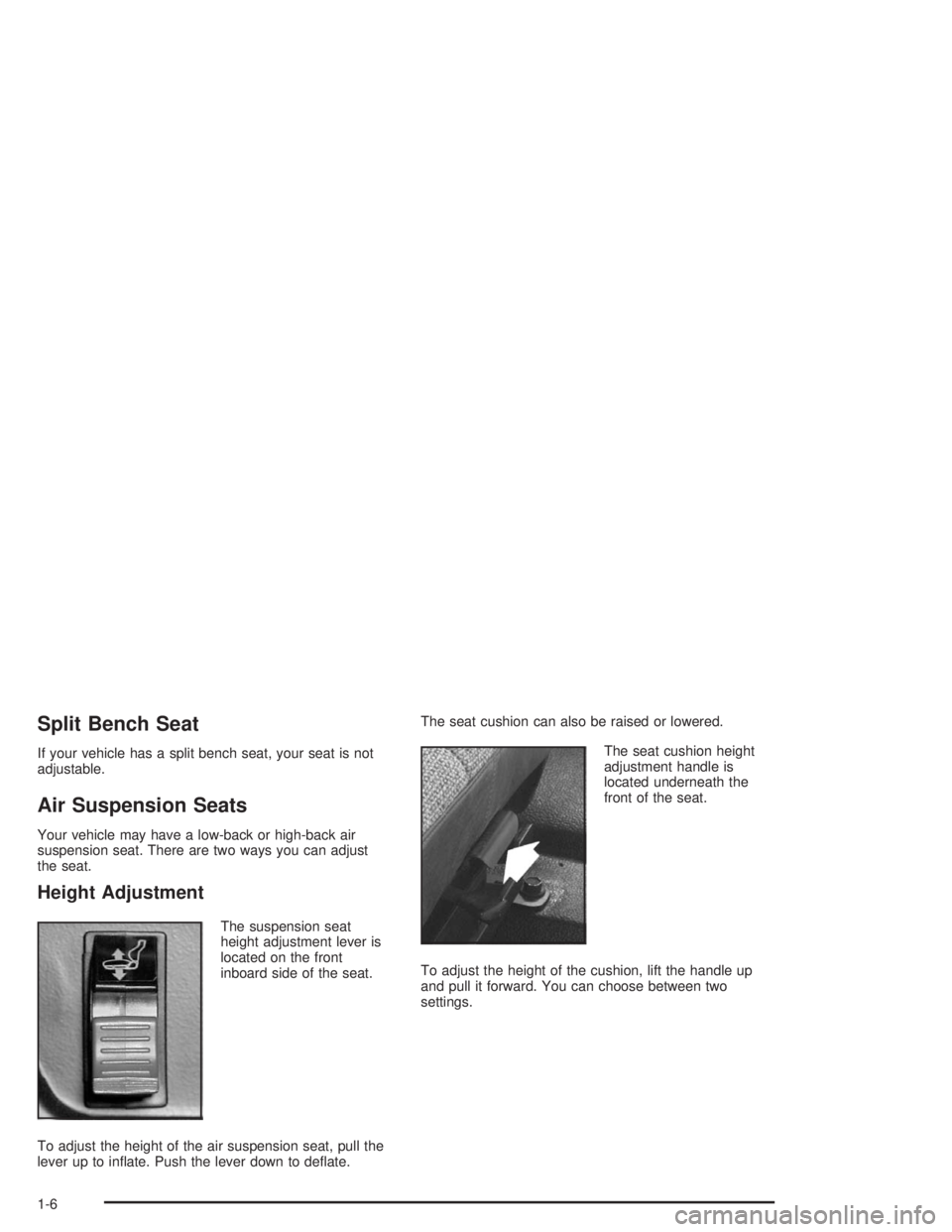
Split Bench Seat
If your vehicle has a split bench seat, your seat is not
adjustable.
Air Suspension Seats
Your vehicle may have a low-back or high-back air
suspension seat. There are two ways you can adjust
the seat.
Height Adjustment
The suspension seat
height adjustment lever is
located on the front
inboard side of the seat.
To adjust the height of the air suspension seat, pull the
lever up to inflate. Push the lever down to deflate.The seat cushion can also be raised or lowered.
The seat cushion height
adjustment handle is
located underneath the
front of the seat.
To adjust the height of the cushion, lift the handle up
and pull it forward. You can choose between two
settings.
1-6
Page 38 of 366
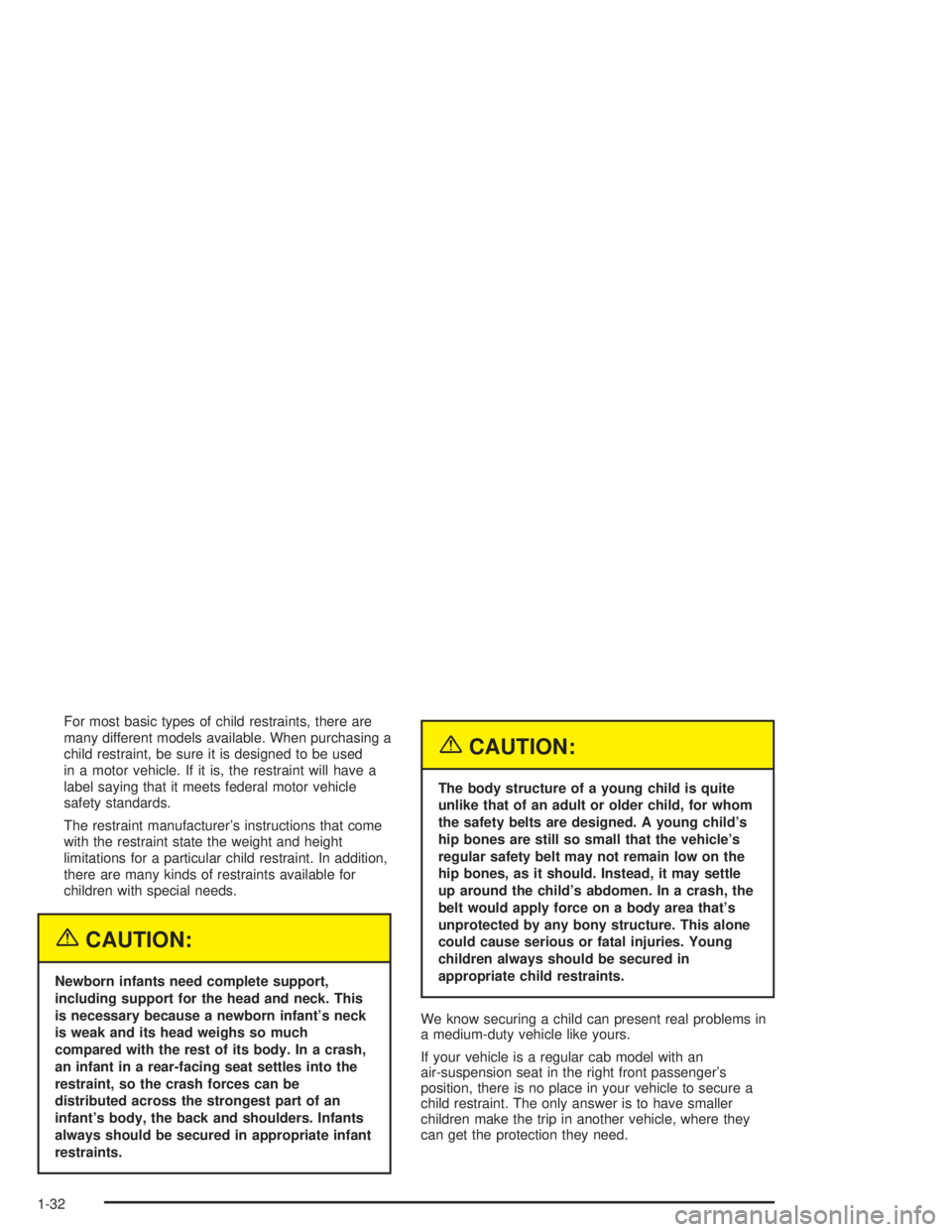
For most basic types of child restraints, there are
many different models available. When purchasing a
child restraint, be sure it is designed to be used
in a motor vehicle. If it is, the restraint will have a
label saying that it meets federal motor vehicle
safety standards.
The restraint manufacturer’s instructions that come
with the restraint state the weight and height
limitations for a particular child restraint. In addition,
there are many kinds of restraints available for
children with special needs.
{CAUTION:
Newborn infants need complete support,
including support for the head and neck. This
is necessary because a newborn infant’s neck
is weak and its head weighs so much
compared with the rest of its body. In a crash,
an infant in a rear-facing seat settles into the
restraint, so the crash forces can be
distributed across the strongest part of an
infant’s body, the back and shoulders. Infants
always should be secured in appropriate infant
restraints.
{CAUTION:
The body structure of a young child is quite
unlike that of an adult or older child, for whom
the safety belts are designed. A young child’s
hip bones are still so small that the vehicle’s
regular safety belt may not remain low on the
hip bones, as it should. Instead, it may settle
up around the child’s abdomen. In a crash, the
belt would apply force on a body area that’s
unprotected by any bony structure. This alone
could cause serious or fatal injuries. Young
children always should be secured in
appropriate child restraints.
We know securing a child can present real problems in
a medium-duty vehicle like yours.
If your vehicle is a regular cab model with an
air-suspension seat in the right front passenger’s
position, there is no place in your vehicle to secure a
child restraint. The only answer is to have smaller
children make the trip in another vehicle, where they
can get the protection they need.
1-32
Page 41 of 366
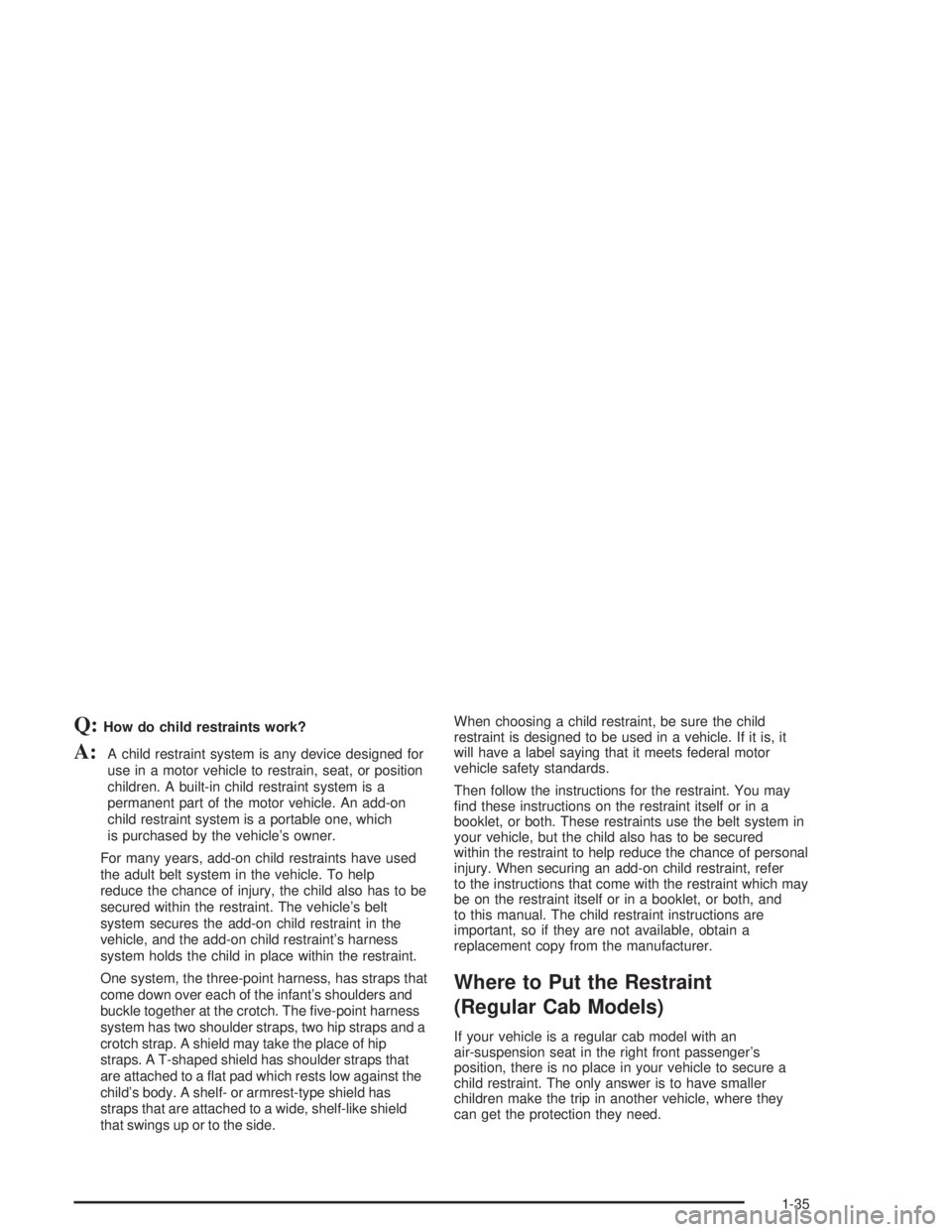
Q:How do child restraints work?
A:A child restraint system is any device designed for
use in a motor vehicle to restrain, seat, or position
children. A built-in child restraint system is a
permanent part of the motor vehicle. An add-on
child restraint system is a portable one, which
is purchased by the vehicle’s owner.
For many years, add-on child restraints have used
the adult belt system in the vehicle. To help
reduce the chance of injury, the child also has to be
secured within the restraint. The vehicle’s belt
system secures the add-on child restraint in the
vehicle, and the add-on child restraint’s harness
system holds the child in place within the restraint.
One system, the three-point harness, has straps that
come down over each of the infant’s shoulders and
buckle together at the crotch. The five-point harness
system has two shoulder straps, two hip straps and a
crotch strap. A shield may take the place of hip
straps. A T-shaped shield has shoulder straps that
are attached to a flat pad which rests low against the
child’s body. A shelf- or armrest-type shield has
straps that are attached to a wide, shelf-like shield
that swings up or to the side.When choosing a child restraint, be sure the child
restraint is designed to be used in a vehicle. If it is, it
will have a label saying that it meets federal motor
vehicle safety standards.
Then follow the instructions for the restraint. You may
find these instructions on the restraint itself or in a
booklet, or both. These restraints use the belt system in
your vehicle, but the child also has to be secured
within the restraint to help reduce the chance of personal
injury. When securing an add-on child restraint, refer
to the instructions that come with the restraint which may
be on the restraint itself or in a booklet, or both, and
to this manual. The child restraint instructions are
important, so if they are not available, obtain a
replacement copy from the manufacturer.
Where to Put the Restraint
(Regular Cab Models)
If your vehicle is a regular cab model with an
air-suspension seat in the right front passenger’s
position, there is no place in your vehicle to secure a
child restraint. The only answer is to have smaller
children make the trip in another vehicle, where they
can get the protection they need.
1-35
Page 42 of 366

{CAUTION:
A child restraint cannot be secured properly in
an air-suspension type seat. This is because
an air-suspension seat is designed to move up
and down for an adult passenger. Don’t use a
child restraint in an air-suspension seat.
If your vehicle is a regular cab model with a static seat
in the right front passenger’s position, or if it has a
bench seat, the child restraint must be secured properly
in the right front passenger’s seat. If your vehicle has
air bags and you need to secure a child restraint in the
right front passenger’s seat, there is a switch on the
instrument panel that you can use to turn off the
passenger’s air bag. SeeAir Bag Off Switch on
page 1-55andSecuring a Child Restraint in the Right
Front Seat Position on page 1-43for more on this,
including important safety information.
Unless the passenger’s air bag has been turned off,
never put a rear-facing child restraint in this vehicle.
Here is why:
{CAUTION:
A child in a rear-facing child restraint can be
seriously injured or killed if the passenger’s air
bag in�ates. This is because the back of the
rear-facing child restraint would be very close
to the in�ating air bag. Do not use a
rear-facing child restraint in this vehicle unless
the passenger’s air bag has been turned off.
Even though the air bag off switch is designed
to turn off the passenger’s frontal air bag, no
system is fail-safe, and no one can guarantee
that an air bag will not deploy under some
unusual circumstance, even though it is turned
off. We recommend that rear-facing child
restraints be transported in vehicles with a
rear seat that will accommodate a rear-facing
child restraint, whenever possible.
If you secure a forward-facing child restraint in
the right front static seat or right front bench
seat, always move the passenger seat as far
back as it will go.
Keep in mind that an unsecured child restraint can
move around in a collision or sudden stop and injure
people in the vehicle – even when no child is in it.
1-36
Page 44 of 366
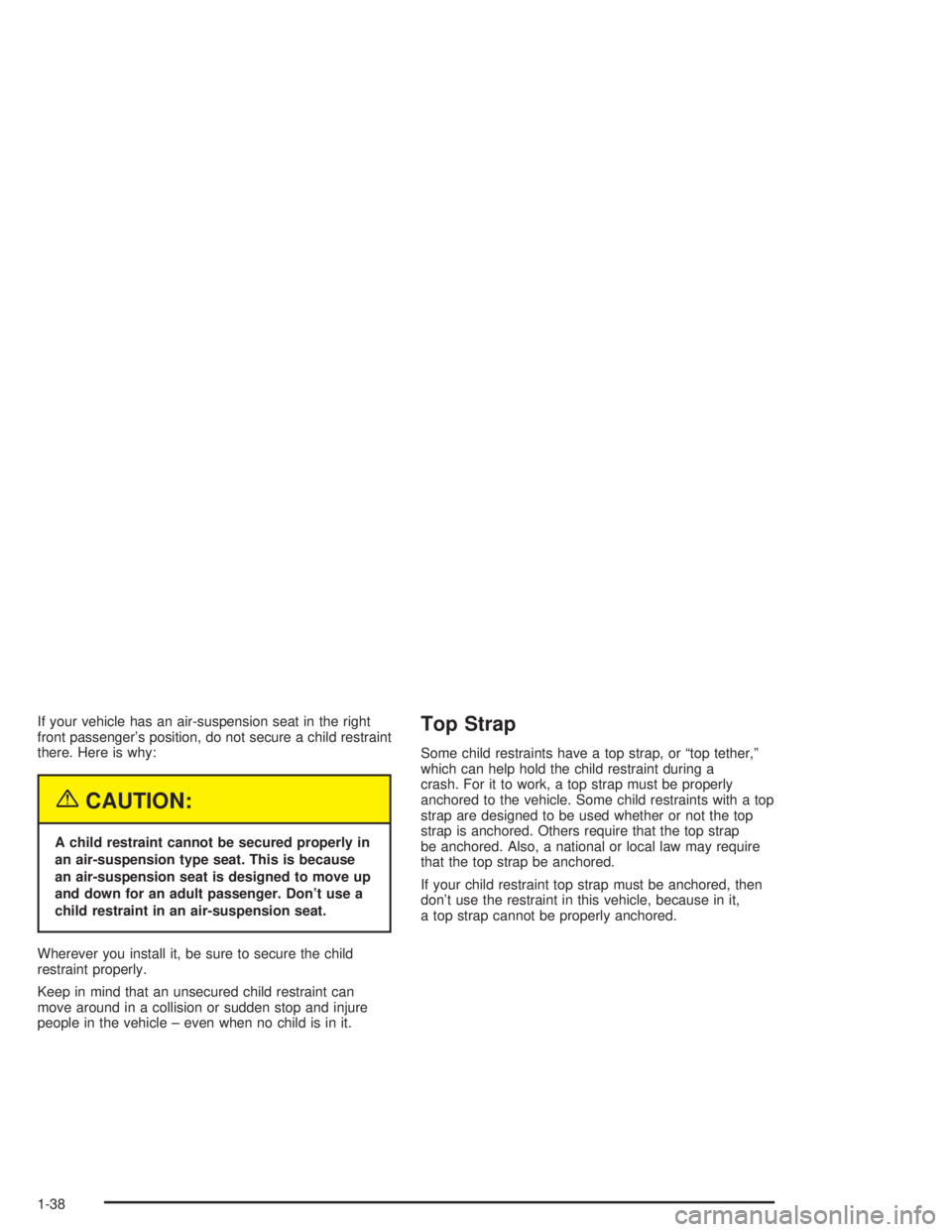
If your vehicle has an air-suspension seat in the right
front passenger’s position, do not secure a child restraint
there. Here is why:
{CAUTION:
A child restraint cannot be secured properly in
an air-suspension type seat. This is because
an air-suspension seat is designed to move up
and down for an adult passenger. Don’t use a
child restraint in an air-suspension seat.
Wherever you install it, be sure to secure the child
restraint properly.
Keep in mind that an unsecured child restraint can
move around in a collision or sudden stop and injure
people in the vehicle – even when no child is in it.
Top Strap
Some child restraints have a top strap, or “top tether,”
which can help hold the child restraint during a
crash. For it to work, a top strap must be properly
anchored to the vehicle. Some child restraints with a top
strap are designed to be used whether or not the top
strap is anchored. Others require that the top strap
be anchored. Also, a national or local law may require
that the top strap be anchored.
If your child restraint top strap must be anchored, then
don’t use the restraint in this vehicle, because in it,
a top strap cannot be properly anchored.
1-38
Page 49 of 366
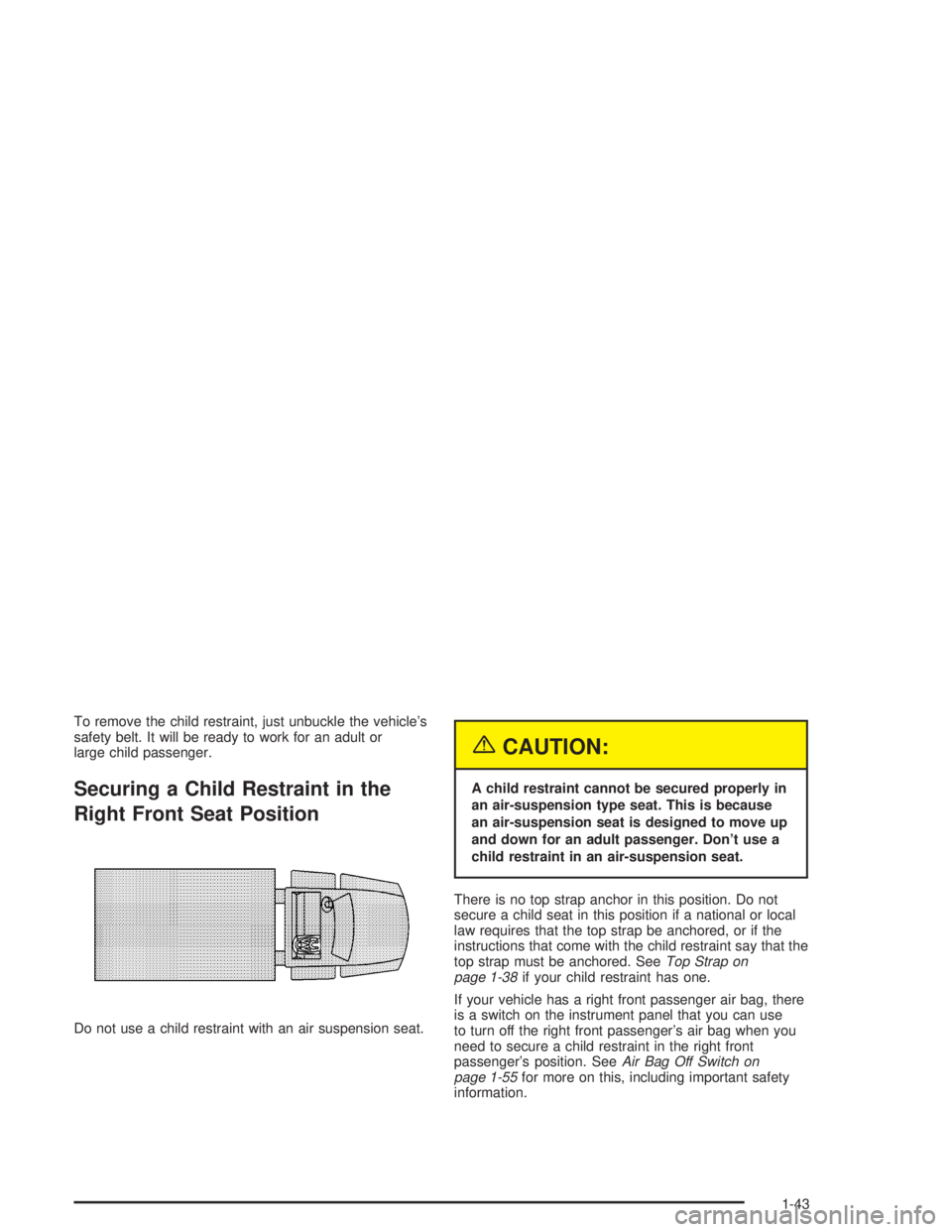
To remove the child restraint, just unbuckle the vehicle’s
safety belt. It will be ready to work for an adult or
large child passenger.
Securing a Child Restraint in the
Right Front Seat Position
Do not use a child restraint with an air suspension seat.
{CAUTION:
A child restraint cannot be secured properly in
an air-suspension type seat. This is because
an air-suspension seat is designed to move up
and down for an adult passenger. Don’t use a
child restraint in an air-suspension seat.
There is no top strap anchor in this position. Do not
secure a child seat in this position if a national or local
law requires that the top strap be anchored, or if the
instructions that come with the child restraint say that the
top strap must be anchored. SeeTop Strap on
page 1-38if your child restraint has one.
If your vehicle has a right front passenger air bag, there
is a switch on the instrument panel that you can use
to turn off the right front passenger’s air bag when you
need to secure a child restraint in the right front
passenger’s position. SeeAir Bag Off Switch on
page 1-55for more on this, including important safety
information.
1-43